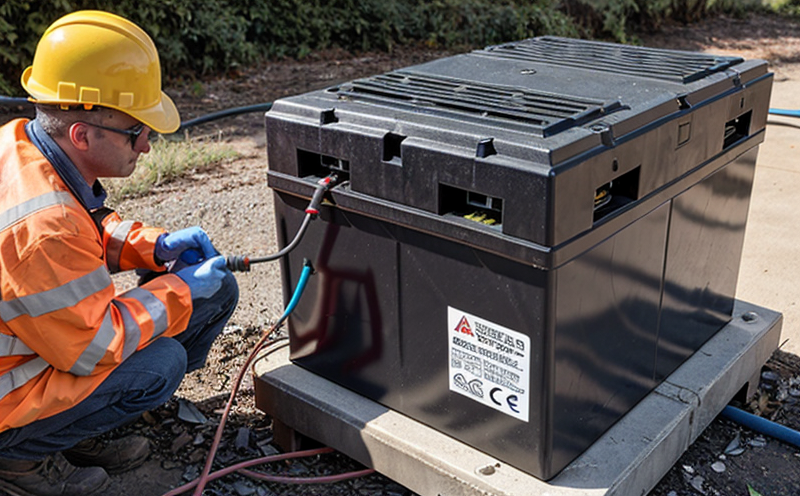IEC 60896-11 Lead-Acid Stationary Battery Performance Testing
The IEC 60896-11 standard provides a comprehensive framework for the performance testing of lead-acid stationary batteries. This service ensures that batteries meet stringent safety, durability, and operational requirements set by international standards, which are critical for applications in telecommunications, uninterruptible power supplies (UPS), and renewable energy storage systems.
The testing covers various aspects such as electrical performance, thermal stability, mechanical integrity, and chemical compatibility under defined conditions. The primary goal is to validate that the batteries perform reliably over their expected service life, ensuring they meet regulatory requirements and customer expectations for safety and efficiency.
For quality managers and compliance officers, this test ensures adherence to global standards, thereby reducing risks associated with non-compliance. R&D engineers can leverage these results to optimize design parameters while procurement teams ensure the reliability of the batteries they source.
The testing process involves a series of rigorous procedures designed to simulate real-world operating conditions. This includes deep discharge tests, float charge stability checks, and accelerated life cycle simulations that replicate harsh environmental stresses like temperature fluctuations and overcharging.
One of the key aspects is ensuring accurate specimen preparation. The batteries are conditioned according to the specified criteria in IEC 60896-11 before testing begins. This includes charging and discharging cycles, which ensure that the battery is in a known state at the start of the test.
The instrumentation used for these tests is highly sophisticated, comprising advanced measurement systems capable of recording minute changes in voltage, current, temperature, and other critical parameters. The data collected during testing is analyzed to determine compliance with the specified performance criteria outlined in IEC 60896-11.
Testing under controlled conditions helps identify potential issues early on, allowing for corrective actions before commercial deployment. This proactive approach ensures that batteries are robust enough to handle real-world demands while maintaining safety and reliability standards.
The results of these tests are meticulously documented and reported according to the standard's guidelines. These reports serve as valuable tools for stakeholders involved in product development, quality assurance, and regulatory compliance, providing a clear picture of the battery's performance capabilities.
Scope and Methodology
| Test Parameters | Methodology | Acceptance Criteria |
|---|---|---|
| Electrical Performance | Measure voltage, current, power output during various discharge rates. | Voltage within ±0.5% of nominal value; Power output not less than 95% of rated capacity. |
| Thermal Stability | Monitor temperature rise during operation at different ambient temperatures. | Temperature increase not exceeding 3°C above initial temperature. |
| Mechanical Integrity | Evaluate resistance to mechanical stress through drop testing and vibration simulation. | No visible cracks or deformation after testing. |
| Chemical Compatibility | Determine stability of electrolyte under prolonged exposure conditions. | No significant change in chemical composition as per standard protocols. |
The methodology outlined in IEC 60896-11 ensures that all tests are conducted with precision and repeatability. Each test parameter is critical to ensuring the overall performance and safety of lead-acid stationary batteries, making this service indispensable for manufacturers and users.
Competitive Advantage and Market Impact
- Compliance with International Standards: Adhering to IEC 60896-11 ensures that your products meet global regulatory requirements, opening up international markets.
- Enhanced Product Reliability: Rigorous testing improves product durability and reduces warranty claims by identifying potential weaknesses early on.
- Better Customer Trust: Meeting these stringent standards enhances customer confidence in the quality and reliability of your products.
- Innovation Facilitation: The insights gained from thorough testing can drive innovation in battery technology and design.
The competitive landscape for lead-acid stationary batteries is highly dynamic, with continuous advancements in technology and increasing demand for reliable energy storage solutions. By offering IEC 60896-11 compliant testing, we help our clients stay ahead of the curve, ensuring they meet current and future market demands.
Use Cases and Application Examples
The IEC 60896-11 Lead-Acid Stationary Battery Performance Testing is particularly relevant for applications requiring reliable power supply in critical environments. For instance, in telecommunications infrastructure, where uninterrupted power is essential to prevent service disruptions, these batteries play a crucial role.
In renewable energy systems, such as solar and wind installations, the ability of lead-acid batteries to store excess energy during peak production periods and release it when demand exceeds supply is vital for grid stability. This testing ensures that batteries can perform reliably in both high-demand and low-demand scenarios.
For uninterruptible power supplies (UPS) used in data centers and hospitals, the reliability of these batteries cannot be overstated. They provide a critical buffer during power outages, ensuring continuous operation even when external power sources fail.
The testing also applies to industrial applications like backup power systems for factories and mining operations, where downtime can lead to significant financial losses. Ensuring that these batteries are robust enough to handle the demands of such environments is crucial.





